#jérôme bonaparte
Text


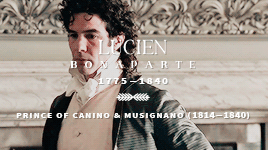


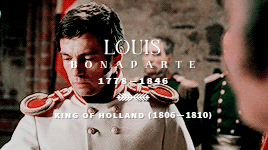
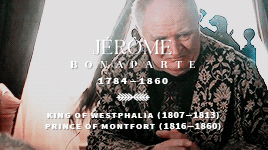

the bonaparte siblings (requested by anon)
"They were not worried about seeming out of place, they did not fear making mistakes or doing something silly; they had no concern for responsibilities; they had a self-confidence that was not even accompanied by a sense of the duties high position entailed. And this self-confidence sustained them despite everything, and so long as their luck held, it made easy for them things that to others seemed simply impossible. […] The audacity to attempt everything, the certainty of succeeding everywhere— in short, all the attributes of genius, except for genius." — Frédéric Masson
J O S E P H's close bond with the Emperor was often tested throughout their political careers, but never broken. He was without question his closest companion but proved to be more successful as a businessman before and after the Empire.
L U C I E N was never offered a crown or a throne, and broke off from the rest of the family as early as the 1800s. He frequently opposed his brothers' views and notably refused to divorce his wife in favor of a diplomatic alliance. Unlike his siblings, his title was bestowed by the Pope.
E L I S A, contrary to her sisters who primarily held consort roles or acted as strawmen, is believed to be the only Bonaparte sister, and only woman, with actual political powers bestowed by the Emperor. She's the only one of the adult siblings to die before him.
L O U I S' frequent conflicts with the Emperor led Napoléon to annex the Kingdom of Holland in 1810, driving him and his family into exile. Louis would go on to become the father of Napoléon III.
Despite a tumultuous relationship, P A U L I N E was considered Napoléon's favorite sister, and proved to be the most loyal of the imperial siblings, liquidating her assets and visiting him in Elba.
Often regarded as the most influential of the Bonaparte sisters, C A R O L I N E was constantly caught in-between her husband and her brother. She was instrumental in the divorce and remarriage of the Emperor. Her political legacy not only didn't survive the fall of the Empire, but effectively predated it through a series of conflicts with her brother.
J E R O M E was the last sibling standing by 1860, and out of them all was the only one to support the Emperor at Waterloo. He would also be the only one to see the re-creation of the Empire and his nephew on the throne.
#perioddramaedit#historyedit#mine#19th century#*#napoléon bonaparte#jérôme bonaparte#elisa bonaparte#pauline bonaparte#louis bonaparte#lucien bonaparte#caroline bonaparte#joseph bonaparte
287 notes
·
View notes
Text
Les Invalides -inside the Dome










#France trip 2023#Les Invalides#Joseph Bonaparte#Jérôme Bonaparte#Napoleon#Napoleon Bonaparte#France
235 notes
·
View notes
Text
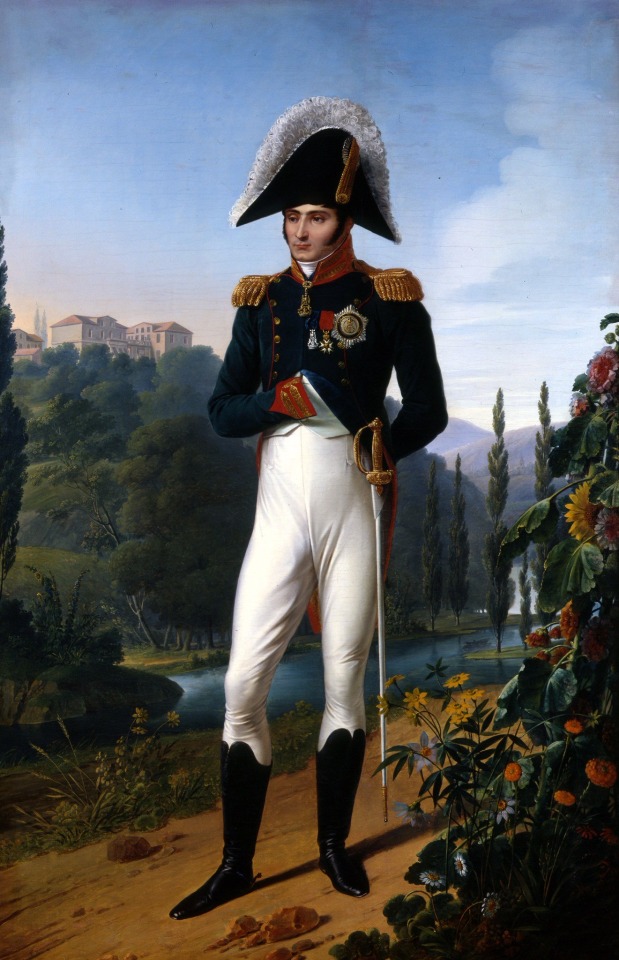
Jérôme in his daddy long leg era
Portrait of Jérôme Bonaparte by François-Joseph Kinson, c. 1807-1813, The Bowes Museum
#jerome bonaparte#Jerome#Napoleon’s brothers#Jérôme#Jérôme Bonaparte#François-Joseph Kinson#Kinson#napoleonic era#napoleonic#first french empire#french empire#art#19th century art#19th century#history#1800s art#bicorne#Barnard Castle#The Bowes Museum#Bowes Museum#Napoleon’s family#Napoleon’s siblings
26 notes
·
View notes
Text
EIGHT SURVIVING CHILDREN OF CARLO AND LETIZIA BONAPARTE, SIBLINGS OF NAPOLEON I 🥺🌟♥️

254 years ago on this day, Napoleon Bonaparte, the first French emperor was born
On the occasion of his birthday, meet the Eight surviving children of Carlo and Letizia Bonaparte, who lived to adulthood
Letizia Bonaparte gave birth to 13 children between 1768 and 1784; five of them died, two at birth and three in their infancy...😥🥀
Among the 13 children, the first child who died was Napoleone Buonaparte, who was born on August 17, 1765 and died on the same day... The last child to die was Jérôme Bonaparte, who died 95 years after his eldest brother...
The registered names of all the children of Carlo and Letizia Bonaparte:
• Napoleone Buonaparte (born and died 17 August 1765)
• Maria Anna Buonaparte (3 January 1767 – 1 January 1768)
• Joseph Bonaparte (7 January 1768 – 28 July 1844)
• Napoleon Bonaparte (Later French emperor) (15 August 1769 – 5 May 1821)
• Maria Anna Buonaparte (14 July 1771 – 23 November 1771)
• A stillborn child (1773)
• Lucien Bonaparte (21 March 1775 – 29 June 1840)
• Maria Anna (Elisa) Bonaparte (3 January 1777 – 7 August 1820)
• Louis Bonaparte (2 September 1778 – 25 July 1846)
• Pauline Bonaparte (20 October 1780 – 9 June 1825)
• Caroline Bonaparte (25 March 1782 – 18 May 1839)
• Jérôme Bonaparte (15 November 1784 – 24 June 1860)
#Carlo Buonaparte#Letizia Bonaparte#Joseph Bonaparte#Napoleon Bonaparte#Lucien Bonaparte#Elisa Bonaparte#Louis Bonaparte#Pauline Bonaparte#Caroline Bonaparte#Jérôme Bonaparte
64 notes
·
View notes
Text
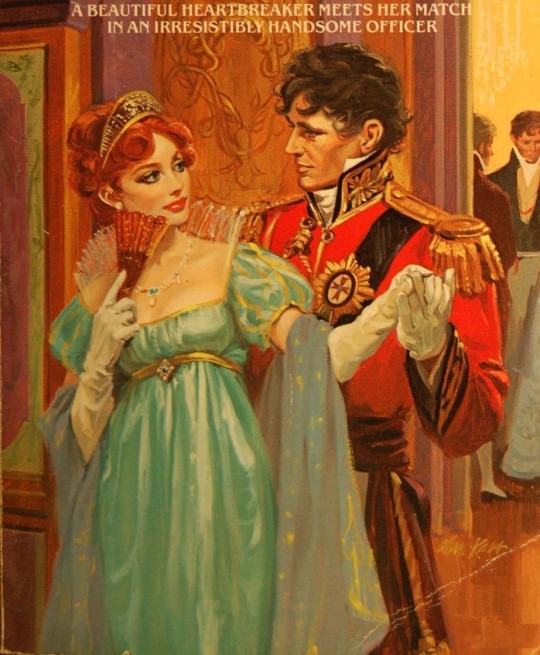

Barbara Childe:
Propaganda:
“Heroine of An Infamous Army. Appears and is instantly described as having "hair like my best copper coal scuttle" Accidentally has an emotional affair with a guy. When it is pointed out to her his wife is mad as hell, decides to do it on purpose because his wife was rude when she was trying to scotch scandal.”
Jérôme Bonaparte
Propaganda:
“Napoleon’s little bro. He was very handsome. His grandson created the FBI, so that’s a thing. The painting of him by Antoine-Jean Gros is awesome. He employed the Grimm brothers (Jacob Grimm was his librarian). Ruled part of Germany (Westphalia). One of Napoleon’s councilors of state, Louis-Philippe de Trémont, described Jérôme as a “half-educated, frivolous, prodigal and effeminate young satrap and sybarite” and if that isn’t just the darnedest description, I don’t what it is.”
The Gros Portrait in question:
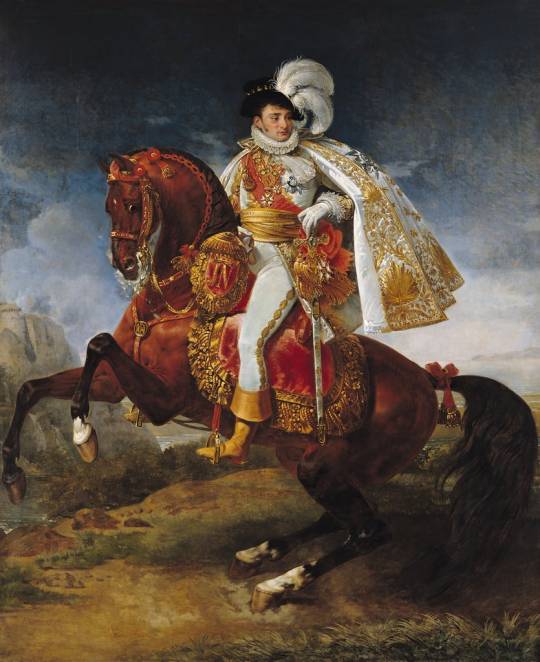
#napoleonic sexyman tournament#also i wanted to use the portrait of jerome on a ship#because it makes him look hot#but i could not find a decent quality unwatermarked version#so if anyone in the napoleonic fandom has it...
75 notes
·
View notes
Text


The Life of Joan of Arc – Jules-Eugène Lenepveu // Louis XIV at the Taking of Besancon – Adam Frans van der Meulen // William III of England – Jan Wyck // Infant-Cardinal Don Fernando of Austria on Horseback – Gaspar de Crayer // Portrait of Johan Wolphert van Brederode – School of Thomas de Keyser // Equestrian Portrait of Philippe de France – Pierre Mignard // Karl XI, King of Sweden – David Klöcker Ehrenstrahl // Equestrian Portrait of Louis XIV – René-Antoine Houasse // Equestrian Portrait of Charles XI of Sweden – David Klöcker Ehrenstrahl // Herzog Karl V. von Lothringen – unknown artist // King Charles XI of Sweden Riding a Horse – David Klöcker Ehrenstrahl // Louis-Philippe, Duc d’Orleans, Saluting His Army on the Battlefield – Alexander Roslin // Equestrian Portrait of Philip IV – Diego Velázquez // Jérôme Bonaparte, King of Westphalia – Antoine-Jean Gros // Equestrian Portrait of King George II – Joseph Highmore // Equestrian Portrait of William II, Prince of Orange – Anselm van Hulle // Equestrian Portrait of King William III – Jan Wyck // Guy On A Horse – Maisie Peters
#as soon as i heard maisie reference joan of arc you know i had to make an edit for it#also i heard this song and immediately thought “lmao all those thousands of equestrian portraits”#they truly are all just a guy on a horse#joan of arc#jeanne d'arc#saint joan of arc#equestrian portrait#equestrian portraiture#guy on a horse#the good witch#the good witch maisie peters#maisie peters the good witch#tgw maisie peters#tgw#maisie peters tgw#the good witch deluxe#maisie peters#art#art history#lyrics#lyric art
107 notes
·
View notes
Text
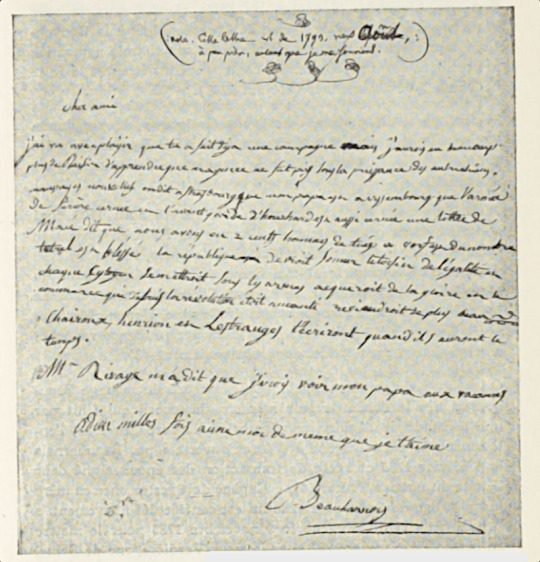
(Sorry to bother folks with yet another non-art post about non-popular guys but I was so excited to find this I just have to tell somebody!)
The "Revue du Rhin" from September 1937 published a letter from Eugène de Beauharnais and another from Jérôme Bonaparte to Eugène. And the letter scribbled written by Eugène is the earliest I've come across so far - his dad is still alive at that point and still at the head of the army (while he has already failed to defend Mainz).
The letter is directed at one Louis Apffel, an obviously somewhat older friend, as he seems to be already with the army. It's undated, but the recipient has noted on top that he believes to have received it in August 1793, which would fit the events mentioned in the letter. The translation, including random capitalization and lack of punctuation, reads:
-
Dear Friend,
I saw with pleasure that you have already made a campaign but I would have had much more Pleasure to learn that Mayence was not under the power of the Austrians, bad news one says in Strasbourg that my papa is in Wissembourg that the army of Ferrière is surrounded and the vanguard of Houchard is also surrounded a letter of Macé says that we had 2 hundred men killed in Vorth is of the number tetrel is wounded, the republic should sound the tocsin of legality and each citizen would put himself under arms would acquire glory and the trade which since the revolution was destroyed would come back more beautiful - Chairoux, henrion and Lestranges will write to you when they have time.
Monsieur Rivage told me that I would be going to see my papa during the holidays.
Adieu a thousand times, love me as much as
I love you
Beauharnais
-
Eugène at this point is 11 years old, and as the article states, him talking about events in the war in such detail and especially him considering the effects on trade are somewhat strange for a boy his age. What Eugène obviously does not suspect yet is the consequences the loss of Mayence would have for his father, who would soon leave the army and try to make himself forgotten, before being arrested and, not quite a year after Eugène wrote this letter, executed.
The article continues to describe Alexandre de Beauharnais' military record in not exactly flattering terms 😋 and to identify the generals, classmates and teachers Eugène mentions.
The second letter is one of recommendation, written four years later, in 1797, by Jérôme, most likely for the same Louis Apffel who had come to visit his former classmate in his college of Saint-Germain (probably in order to get in contact with Eugène's new stepfather), only to learn that Eugène three months earlier had left for Italy as general Bonaparte's aide-de-camp. Apparently he was going to follow him there and wanted to make sure he would be allowed to approach the general's family.
And if you thought Eugène's handwriting was bad, here's Jérôme:
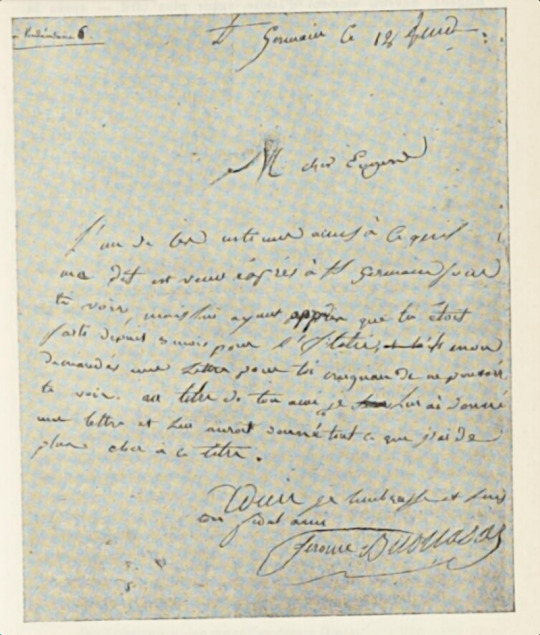
Translation:
My dear Eugène
One of your close friends, as he tells me, came expressly to St. Germain to see you, but on learning that you had left 3 months ago for Italy, they asked me for a letter for you, fearing that they would not be able to see you. In the name of your friend I gave him a letter and would have given him everything I hold dearest in this capacity.
Farewell, I embrace you and I am your faithful friend.
Jérôme Buonaparte
-
I like how Jérôme is obviously not stupid (your friend "as he tells me" - who however doesn't know your whereabouts). And as he speaks of several people who wanted to get in touch with Eugène, now that Eugène was the stepson of the most famous army general, I wonder if this may have been the whole family of Louis Apffel, trying to take advantage of the fact their son had once been in school with Eugène.
15 notes
·
View notes
Text

Buste en hermès de Jérôme Bonaparte
Roi de Westphalie (1784-1860)
François-Joseph Bosio, Musée Fesch.
29 notes
·
View notes
Text

"Coffret Ecritoire" par Martin-Guillaume Biennais, ayant appartenu à Jérôme Bonaparte, Roi de Westphalie, offert par son épouse Catherine de Wurtemberg (1810) pendant la visite-privée du Musée de la Légion d'Honneur organisée par son conservateur Tom Dutheil et l'Association d'Histoire de la Bijouterie-Joaillerie, mars 2024.
#expos#nacre#Bonaparte#Wurtemberg#Biennais#Dutheil#MuseeLegionHonneur#AssociationHistoireBijouterieJoaillerie#AHBJ
2 notes
·
View notes
Text
Everyone on earth knows about Napoleon’s will except for Jerome
Letter from Catherine [Jérôme’s wife] to Joseph Bonaparte 1 May 1823
Le maréchal Bertrand ni le général Montholon n'ont jugé à propos de nous faire connaître le testament de l'empereur, tandis que tous les souverains alliés, le duc de Leuchtenberg [Eugène] et Hortense en ont été informés et que les gazettes anglaises en ont instruit le public. On nous assure que telle a été l'intention de l'empereur, je me refuse à le croire; quelle raison aurait-il eue de nous traiter avec un si grand mépris, lui ayant donné, dans tous les moments de danger et de péril, des marques d'un dévouement absolu! J'aime donc mieux croire que c'est un oubli et un manque d'égards de la part de ces Messieurs, que d'avoir été exclus de la pensée de l'empereur dans ses derniers moments. Cette idée jetterait trop d'amertume sur notre existence qui n'en est déjà que trop abreuvée.
---
Neither Marshal Bertrand nor General Montholon thought fit to let us know the contents of the Emperor's will, while all the allied sovereigns, the Duke of Leuchtenberg [Eugène] and Hortense were informed of it and the English gazettes informed the public. We are assured that such was the Emperor's intention. I refuse to believe it; what reason would he have had to treat us with such great contempt, having given him in all moments of danger and peril marks of absolute devotion! I therefore prefer to believe that it was an oversight and a lack of consideration on the part of these Gentlemen, than to have been excluded from the thoughts of the Emperor in his last moments. This idea would throw too much bitterness on our existence which is already only too steeped in it.
— Correspondance inédite de la reine Catherine de Westphalie, née princesse de Wurtemberg avec sa famille et celle du roi Jérôme, les souverains étrangers et divers personnages, publiée par A. du Casse.
28 notes
·
View notes
Text
Napoléon & Joséphine : Mariage arrangé
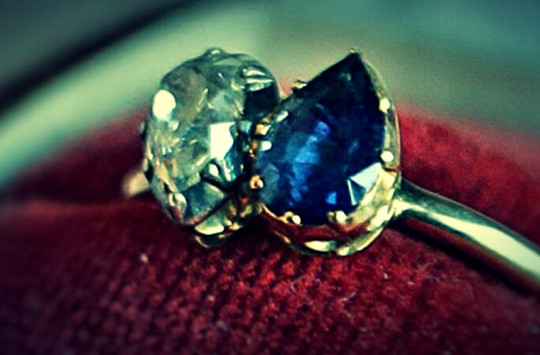
Le dimanche 21 septembre 2014, lors d'une vente aux enchères à Rueil-Malmaison, le Musée des lettres et des manuscrits de Paris avait acquis pour 350000 euros (437500 euros, taxes comprises) le contrat de mariage liant le général Napoléon Bonaparte à Marie-Josèphe Rose Tascher dite Joséphine. Cet exemplaire est celui de l'Impératrice Joséphine. Les Archives nationales conservent celui de Napoléon. Le 24 mars 2013, la bague de fiançailles était adjugée à 896400 euros à la maison Osenat de Fontainebleau.
Date : 9 mars 1796
Lieu : mairie du 2e arrondissement de Paris, à l'hôtel Mandragon, rue d'Antin.
Début février 1796, le général Napoléon Bonaparte et Joséphine (Marie-Josèphe Rose Tascher) décidèrent de se marier - publication du 7 février, 17 ventôse an IV.
A l'époque, l'annonce de ce mariage surprit et dérangea l'entourage à cause de leurs différences : Joséphine, âgée de 32 ans, veuve du général Alexandre de Beauharnais, mère de deux enfants. Napoléon, âgé de 26 ans, sans enfant.
Bien que fort séduit, Napoléon comprit aussi tout l'avantage de s'unir avec l'amie de Paul Barras, l’homme fort du gouvernement de la Première République française. Le 9 mars, après 22h00, le mariage fut prononcé à la mairie du 2e arrondissement de Paris, à l'hôtel Mandragon, rue d'Antin. Le 18 mars, le contrat fut enregistré et les copies authentiques destinées aux époux furent envoyées.
Autorités présentes
Collin-Lacombe, commissaire ;
Maurice-Jean Raguideau de La Fosse, notaire ;
Étienne-Gabriel Jousset, notaire.
Témoins des mariés
Paul Barras, membre du directoire exécutif ;
Capitaine Jean Lemarois, aide-de-camp de Napoléon ;
Jean-Lambert Talien, membre du corps législatif ;
Étienne-Jacques-Jérôme Calmelet, homme de loi.
Toutes les modifications et étrangetés
Pour se conformer aux mœurs de l'époque, les âges des mariés ont été modifiés. Joséphine est rajeunie de quatre ans, soit 28 ans, et Napoléon est vieilli d'un an, soit 28 ans, né le 5 février 1768 au lieu du 15 aout 1769 (cette date est antérieure au 15 mai 1768, date du traité de Versailles attestant l'occupation et l'administration de la Corse par le Royaume de France).
L'adresse du domicile de Napoléon n'est pas rue d'Antin, mais rue Neuve des Capucines, aujourd'hui rue des Capucines.
Napoléon est désigné comme général en chef de l’armée de l’Intérieur, alors que le 2 mars, il fut nommé commandant en chef de l’armée d’Italie.
La minute du contrat fut signée le 8 mars devant les notaires Raguideau de La Fosse et Jousset et en présence du capitaine Lemarois.
Charles-Théodore-François Leclercq, officier public de l'état-civil du 2e arrondissement du canton de Paris, est désigné comme autorité du mariage, mais il partit avant et fut remplacé par le commissaire Collin-Lacombe.
L'article 1er du contrat indique que les époux ne seront nullement tenus des dettes et hypothèques l’un de l’autre, mais 3 ans plus tard, le 18 avril 1799, une apostille du tribunal civil de la Seine vint se joindre au contrat, attestant l’inscription d’un acte privé sur un registre public. En effet, pendant que Napoléon était en Orient, Joséphine demanda la séparation des biens avant son achat du château de Malmaison. Elle emprunta pour cela des sommes que son mari rembourserait personnellement à son retour.
Extrait original
Article 1er. Il n'y aura aucune communauté de biens entre les futurs époux… en conséquence les futurs époux ne seront nullement tenus des dettes et hypothèques l’un de l’autre.
"Par devant les notaires à Paris soussignés, furent presens Napolione Buonaparte, général en chef de l’armée de l’Intérieur, demeurant à Paris, rue d’Antin…, originaire d’Ajaccio en Corse, fils de défunt
Charles Buonaparte et de Letizien Ramolini, son épouse, actuellement sa veuve, stipulant pour lui et en son nom, d’une part, et Marie Josephe Rose Tascher, veuve d'Alexandre François Marie Beauharnois, duquel elle a deux enfans, Eugène et Hortense, demeurant à Paris, rue Chantereine…, la dite citoyenne née en l’isle Martinique du mariage de Gaspard Tascher, capitaine de Dragons et Rose Claire Des Vergers, son épouse, stipulant pour elle et en son nom, d’autre part, lesquelles parties, dans la vue du mariage proposé entre elles en ont arrêté les conditions civiles ainsi qu’il suit.
Article 3e. Chacun des futurs époux contribuera pour moitié aux charges du mariage.
Article 2e. Chacun des futurs époux jouira à part et divisément des biens, droits et actions tant meubles qu’immeubles lui appartenant et pouvant lui appartenir par la suite à quelque titre et à quelque cause que ce soit et en quoi qu’ils puissent consister… la future épouse ne restant tenue de recourir à l’autorisation de son mari que pour les actes qui emporteroient aliénation de ses capitaux. Le futur époux autorise d’ailleurs la future épouse à continuer les fonctions de la tutelle qui lui a été déférée des deux enfans mineurs issus de son premier mariage…
Article 4e. Le futur époux constitue à la future épouse un douaire de quinze cens livres de rente annuelle et viagère, valeur ancienne…
Article 6e. La future épouse déclare et le futur époux reconnois que les meubles, linges, l’argenterie, et généralement tous les biens meubles corporels dont la future épouse est maintenant en possession appartiennent à la communauté qui a subsisté entre elle et son premier mari et qui a continué avec ses enfans, faute par elle d’avoir fait faire inventaire dans le délai prescrit par la loi. Que la future épouse fait actuellement procéder à cet inventaire et qu’il est sur le point d’être mis à fin. Qu'elle, future épouse, ne peut déclarer maintenant le montant de sa fortune parce que tout dépend de la question de savoir si elle acceptera la communauté ou si elle y renoncera, ce à quoi elle ne peut se déterminer qu’après la confection dudit inventaire…"
Article 5e. Arrivant la dissolution du mariage, la future épouse et ses héritiers reprendront : 1° les habits, linge, hardes, dentelles, argenterie, bijoux et diamants à l’usage personnel de ladite future épouse, 2° tous les meubles et autres objets mobiliers et quelqu’espèce qu’ils soient que la future épouse ou ses héritiers justifieront avoir été acquis par elle ou autrement lui appartenir.
Apostille du tribunal civil de la Seine datée du 18 avril 1799 : "Insinué à Paris au bureau établi près le tribunal civil du département de la Seine le vingt neuf germinal an sept (18 avril 1799)… et transcrit
tout au long les articles premier et cinq au registre de forme dudit tribunal… à la réquisition du porteur qui a signé sur ledit registre et a été averti de la déclaration à faire dans les six mois du décès du prémourant et de réitérer l’insinuation de l’article premier relatif à la non communauté au greffe du tribunal civil…"
5 notes
·
View notes
Text

Jérôme Bonaparte in profile, by Jean-Baptiste Isabey.
[Via MutualArt]
17 notes
·
View notes
Text
Letter from Napoleon to his brother, Jérôme. A really interesting letter as I think it clearly displays his unique idealism:
My concern is for the well-being of your people [Westphalians], not only as it affects your standing and my own, but also because of the impact it has on the whole condition of Europe. Do not listen to anyone who says that your subjects, being so long accustomed to servitude, will fail to feel gratitude for the freedoms you bring to them. The common people of Westphalia are more enlightened than such individuals would have you believe, and your rule will never have a secure basis without the people’s complete trust and affection. What the people of Germany impatiently desire is that men without nobility but of genuine ability will have an equal claim upon your favor and advancement, and that every trace of serfdom and feudal privilege... be completely done away with. Let the blessings of the Code Napoleon, open procedures and use of juries be the centerpiece of your administration... I want all your peoples to enjoy liberty, equality, and prosperity alike and to such a degree as no German people has yet known.... Everywhere in Europe—in Germany, France, Italy, Spain—people are longing for equality and liberal government... So govern according to your new constitution. Even if reason and the enlightened ideas of our age did not suffice to justify this call, it still would be a smart policy for anyone in your position—for you will find that the genuine support of the people is a source of strength to you that none of the absolutist monarchs neighboring you will ever have.
Source: Napoleon to Jérôme, November 15, 1807, in Napoleon, Correspondance générale, ed. Thierry Lentz (Paris: Fayard, 2004), VII: 1321.
English translation: Alexander Mikaberidze, The Napoleonic Wars: A Global History
#Napoleon’s correspondence#Napoleon#napoleon bonaparte#The Napoleonic Wars: A Global History#napoleonic era#napoleonic#first french empire#Jerome#jerome bonaparte#Jérôme Bonaparte#Napoleon’s brothers#Napoleon’s reforms#napoleonic reforms#reforms#Westphalia#Germany#1807#1800s#Thierry Lentz#french empire#19th century#letter#letters
23 notes
·
View notes
Photo



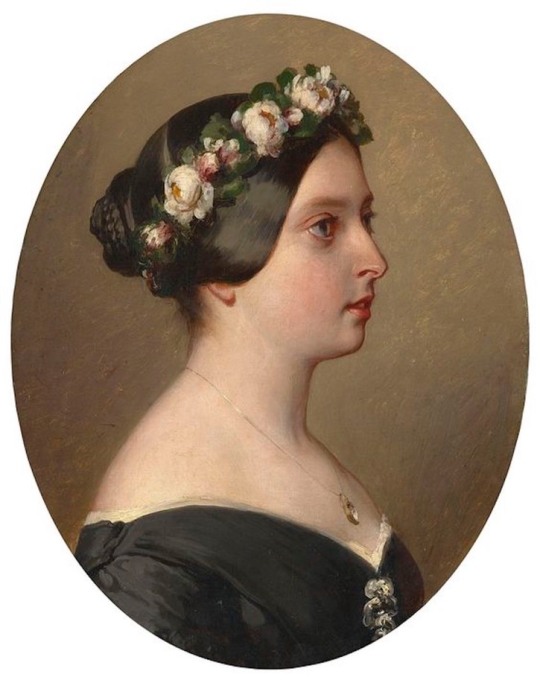

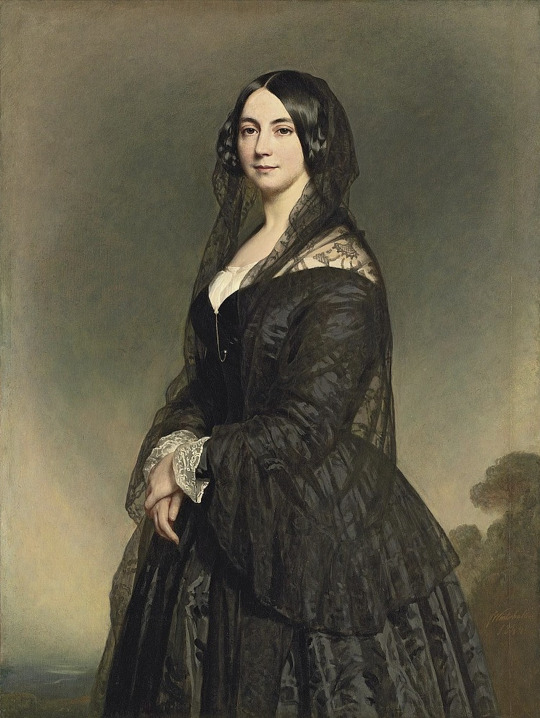



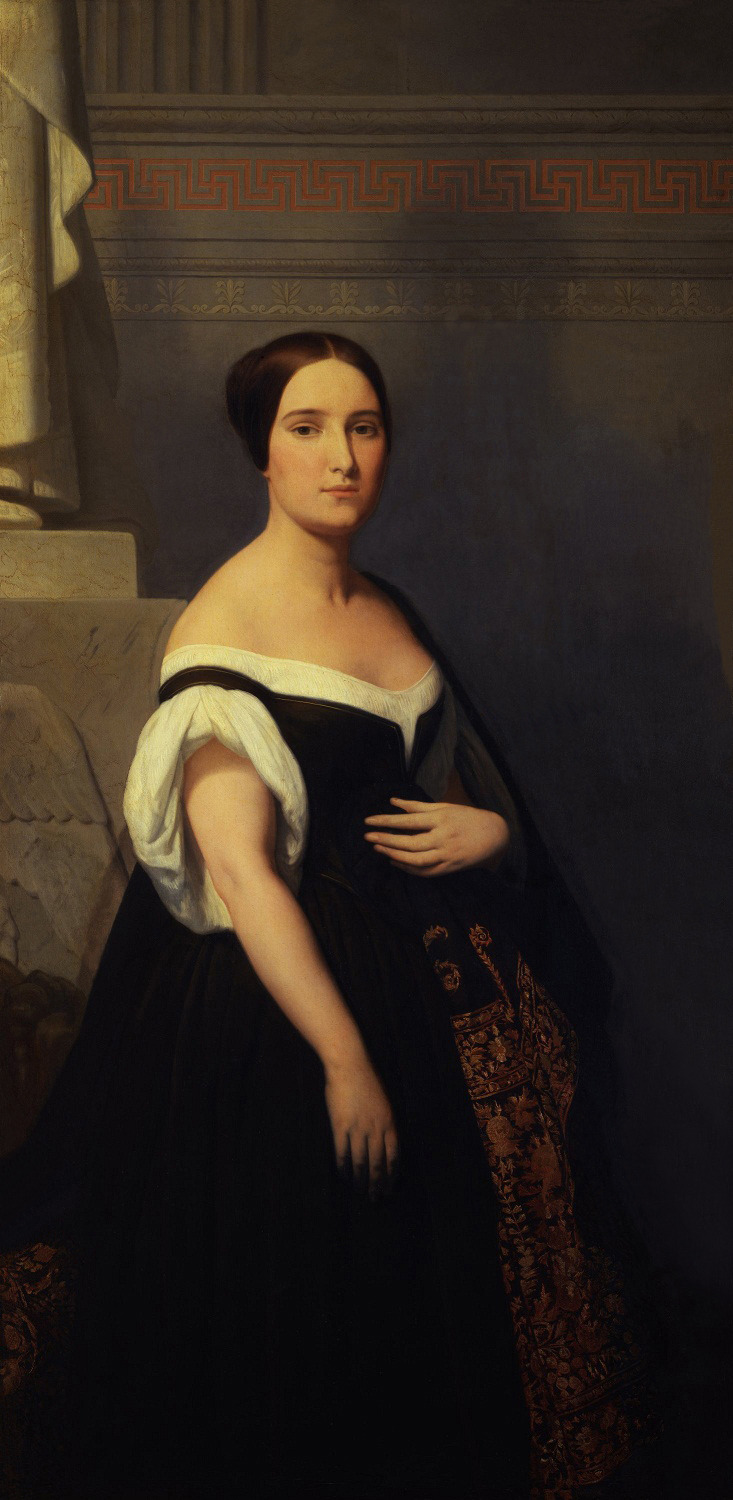
Back to 1844 -
Top: 1844 Josepha Conti by Joseph Karl Stieler (Schönheitengallerie, Schloß Nymphenburg - München, Bayern, Germany). From pinterest.es/amparomanez/arte-entre-las-flores/; fixed spots & cracks w Pshop 1224X1500 @72 649kj.
Second row left: 1844 Comtesse Caroline de Vergès née Caroline Brochant de Villliers (1806-1860) by François Louis Dejuinne (Tajan). Probably from invaluable.com/; fixed edges and spots w Pshop 667X838 @72 657kp.
Second row right: 1844 Grand Princess Alexandra Nicolaievna in red dress by Vladimir Ivanovich Hau (location unknown to gogm) From liveinternet.ru/users/4237948/post296792759/ 840X1012 @72 223kj.
Third row: 1844 Queen Victoria by Franz Xaver Winterhalter (Royal Collection). From pinterest.com/bcourtney0004/victorian-dresses/ enlarged one half 725X917 @72 136kj.
Fourth row left: 1844 Natalia Pushkina by Vlaimir Hau (Hermitage). From Sofi's photostream on flickr 1636X1973 @72 642kj.
Fourth row right: 1844 Lady by Franz Xaver Winterhalter (auctioned by Christie's). From invaluable.com/auction-lot/franz-xaver-winterhalter-mezenschwand-1805-1873-195-c-79a17f0253#; expanded to fit screen 2164X2878 @144 9.2Mp.
Fifth row: 1844 Mary Milner, Dowager Countess of Strathmore by ? (Bowes Museum - Durham, North East England, UK). From thebowesmuseum.org.uk/the-three-graces/; fixed obvious spots & flaws w Pshop 1656X2444 @300 1.7Mj.
Sixth row left: ca. 1844 Mary Shelley attributed to Richard Rothwell (Bodleian Library, Oxford University - Oxford, Oxfordshire, UK). From Wikimedia 1144X1369 @72 3.2Mp. She wrote Frankenstein.
Sixth row right: ca. 1844 Anna Benardaki, née Kipouro by Carl von Steuben (State Hermitage Museum - St. Petersburg, Russia) From the museum's Web site decreased temperature 2408X2914 @150 8Mp.
Bottom: 1844 Princess Mathilde by Ary Scheffer (Galleria d'arte moderna di Firenze - Firenze, Toscana, Italy). From Wikimedia 733X1500 @3200 283kj. Her father, Jérôme Bonaparte, was Napoleon (I) Bonaparte’s brother. She rose to prominence when her cousin rose to power as Napoléon III in 1851.
#1844 fashion#early Victorian fashion#Louis-Philippe fashion#Biedermeier fashion#Josepha Conti#Joseph Karl Stieler#Schönheitengallerie#Caroline de Vergès#François Louis Dejuinne#Alexandra Nicolaievna#Vladimir Ivanovich Hau#Queen Victoria#Franz Xaver Winterhalter#Natalia Pushkina#side curl coiffure#lace wrap#Mary Milner#straight hair#Mary Shelley#Richard Rothwell#Frankenstein#Anna Benardaki#Carl von Steuben#Mathilde Bonaparte#Ary Scheffer.
14 notes
·
View notes
Text
Jerome Bonaparte’s ‘most respectable susceptibilities’ (or not)
Female playwrights often struggled to find the support needed to produce their works. Savari’s fifteen-year effort to stage her most important play, Divorce impérial (1890), illustrates the type of challenges faced by Belle Époque playwrights. A historical drama about the divorce of Napoléon and Josephine, the Divorce impérial was mired in controversy from its beginnings. Initially, Savari’s efforts to stage her play appeared promising. A rumour circulated that it would be performed at l’Eden by the actors of the Comédie Française. The plan failed however when the director of the Comédie, Jules Claretie, refused to allow his actors to perform. In what would become a familiar act of retaliation, Savari published a letter in the press inviting Claretie to explain himself before all of the ‘Paris lettré’: ‘You must have reasons, you, a Potentate of the Republic of Letters,’ wrote Savari, ‘to block the attempts of a debutante who is simply looking to earn her living and that of her children.’[22]
In addition to the challenges in promoting their work, women artists also had to contend with ridicule and predatory behaviours. In the wake of the Claretie controversy, Jérôme Bonaparte, the nephew of Napoléon, wrote a letter that created a stir in the French and international press. Bonaparte accused Savari’s play of offending ‘the most respectable susceptibilities.’ Savari immediately defended herself, citing her conscientious study of Napoleon’s character.[23] Bonaparte’s letter, it turned out, was a hoax, probably intended to ridicule Savari’s abilities as a playwright and to discredit a work that specifically addressed the condition of women in marriage.[24] Savari’s woes as a dramatist were far from over. In 1885, she accused Emile Bergerat, playwright and former journalist colleague at the Gil Blas of having plagiarized the title Divorce impérial. A couple of years later, still intent on producing the play, she was duped by a fraudulent impresario.[25] Ever tenacious, Savari conducted numerous readings of the play throughout this period, in Dieppe, the Hague, Rouen, as well as at London’s Mansion House, the official residence of the Lord Mayor of London.[26] The play was finally performed to positive reviews in 1904, shortly before being approved by the Chambre sur la censure dramatique. [27]
Danielle C. Dubois, ‘Pauline Savari’s practical feminism in the Belle Époque: unionization, cooperatives and insurance for working mothers (1887–1907)’
2 notes
·
View notes
Text
The updated list of nominees so far:
France:
Jean Lannes
Josephine de Beauharnais
Thérésa Tallien
Jean-Andoche Junot
Joseph Fouché
Charles Maurice de Talleyrand
Joachim Murat
Michel Ney
Jean-Baptiste Bernadotte (Charles XIV of Sweden)
Louis-Francois Lejeune
Pierre Jacques Étienne Cambrinne
Napoleon I
Marshal Louis-Gabriel Suchet
Jacques de Trobriand
Jean de dieu soult.
François-Étienne-Christophe Kellermann
Louis Davout
Pauline Bonaparte, Duchess of Guastalla
Eugène de Beauharnais
Jean-Baptiste Bessières
Antoine-Jean Gros
Jérôme Bonaparte
Andre Masséna
England:
Richard Sharpe (The Sharpe Series)
Tom Pullings (Master and Commander)
Arthur Wellesley, 1st Duke of Wellington
Jonathan Strange (Jonathan Strange & Mr. Norrell)
Captain Jack Aubrey (Aubrey/Maturin books)
Horatio Hornblower (the Hornblower Books)
William Laurence (The Temeraire Series)
Austria:
Klemens von Metternich
Friedrich Bianchi, Duke of Casalanza
Franz I/II
Archduke Karl
Marie Louise
Poland:
Wincenty Krasiński
Józef Antoni Poniatowski
Józef Zajączek
Maria Walewska
Russia:
Alexander I Pavlovich
Alexander Andreevich Durov
Prince Andrei (War and Peace)
Pyotr Bagration
Mikhail Miloradovich
Levin August von Bennigsen
Prussia:
Louise von Mecklenburg-Strelitz
Gebard von Blücher
Carl von Clausewitz
Frederick William III
Gerhard von Scharnhorst
Louis Ferdinand of Prussia
Friederike of Mecklenburg-Strelitz
The Netherlands:
Ida St Elme
Wiliam, Prince of Orange
The Papal States:
Pius VII
#napoleonic sexyman tournament#there is something mildly funny about the English being overwhelmingly fictional Englishmen#and Wellington
54 notes
·
View notes